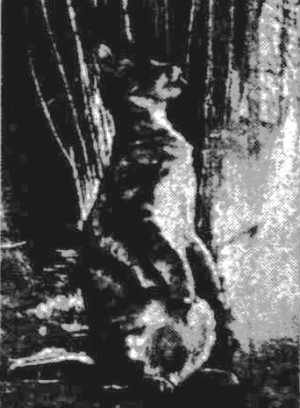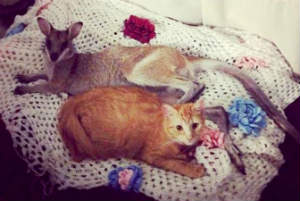Cat-kangaroo Hybrids
Mammalian Hybrids
|
A diligent scholar is like a bee who takes honey from many different flowers and stores it in his hive.
—John Amos Comenius
|
Cat-kangaroo hybrids and wallaby-cat hybrids are occasionally described in old Australian news reports, some of which are quoted below (wallabies are small and medium-sized kangaroos).
One such report appeared in the Queanbeyan Age and General Advertiser (Jan. 26, 1865, p. 27), a newspaper published in Queanbeyan, New South Wales. It reads as follows:
The Empire, where this story originated, was a newspaper published in Sydney. Note that the direction of the cross is specified in this last report (male wallaby × female cat).
A longer report, with a good bit of detail, appears on page 2 of the issue of The Uralla Times and District Advocate (Jul. 31, 1920, p. 2), a newspaper published in Uralla, New South Wales. It reads as follows:
Wallaby-Cat
Mr Kelly’s letter is as follows:—The cat, which I possess now, was caught when a kitten in the Burraka C[ree]k country. Regarding the shape of the head, it shows characteristics of both wallaby and cat. He has only a few odd whiskers. His toes are certainly a cat’s, but he uses the claws after the manner of a kangaroo. He has a short bushy tail, on which he rests when sitting up. His color is black and white. We have trained him to eat meat, but he is unable to catch birds like an ordinary cat. He is very fond of milk and will eat grass. When sleeping or resting, he generally rests his little front paws on the lower rung of an Austrian chair, where he will remain for hours. He is exceedingly intelligent, and will not allow another cat in the house where he is. His method of putting them out is laughable. On his hind legs, with outstretched arms, in apparent boxing manner, he is a lightning hitter, and no ordinary cat can withstand him after the opening hits. At all times of the day he is sitting on his hind legs, and enjoys being petted by anyone he knows. On a stranger touching him he will bite viciously. He has no progeny. I have been approached by two men to dispose of him for show purposes, but I have hesitated, as he is a great pet of the children. I will have his photo taken and send you a copy.”
Mr Bardsley adds that he will send along a copy of the photo when received.
The earlier article, in Smith’s Weekly, (Jun. 19, 1920, p. 18) referenced above, read as follows:
At the Imperial Hotel, Brandon (N.Q.), I came across a cat which led me to believe that its mother had mated with a wallaby. Its two front legs were short, as in a wallaby, its tail was thick and bushy, and it had a distinct liking for lettuce, radishes and celery. Other cats gave it a wide berth. Its method of locomotion was the same as that of a marsupial.—“Sucre.”
Two years later Kelly, the owner of the ostensible wallaby-cat hybrid described in the previous two transcripts wrote in to the Brisbane Daily Mail with further information about this strange creature, including its mode of demise. His communication appeared on page 9 of the November 4, 1922, issue of that publication (source). The relevant portion of his letter reads as follows:
I was offered £50 for him by a travelling showman at Townsville, but refused to part with him, thinking he would be invaluable to the Brisbane museum authorities. However, a couple of nights before I came away. I found him lying dead at the front steps of the house where I was staying. He had been bitten by a snake. My explanation of his death, is that, noticing the snake on the ground, and not knowing what it was, he started to play with it.
Wallabies move only by hopping because their hind legs are much longer than their forelegs. However, in January 2015, an infra-red night cam in a forest north of Sydney captured an animal that in most respects looked like a wallaby, but that moved with a catlike gait. The forelegs were larger in proportion to the hind legs than in a wallaby (this animal is, however, much different from the alleged cat-wallaby pictured in the old news photo below). This is the video:
 Above: Picture of an alleged cat-wallaby hybrid copied from an old newspaper. The image, obviously, is of poor quality, but it shows the animal combined a kangaroo-like posture with a generally catlike physical appearance. The original caption read, “FREAK FELINE - At Vera Park, Charleville, can be seen this ‘cat-wallaby.’ Its front legs are shorter than the hind legs and it always sits in the position shown in the picture. Puss, too, was born with a protruding tongue.” Source: The Week, (Sep. 6, 1933, p. 24), Brisbane, Queensland.
Above: Picture of an alleged cat-wallaby hybrid copied from an old newspaper. The image, obviously, is of poor quality, but it shows the animal combined a kangaroo-like posture with a generally catlike physical appearance. The original caption read, “FREAK FELINE - At Vera Park, Charleville, can be seen this ‘cat-wallaby.’ Its front legs are shorter than the hind legs and it always sits in the position shown in the picture. Puss, too, was born with a protruding tongue.” Source: The Week, (Sep. 6, 1933, p. 24), Brisbane, Queensland.
In the Bendigo Advertiser (Sep. 26, 1912, p. 7), an Australian newspaper published in Bendigo, Victoria, a description of the Bendigo Jubilee Show mentions that “A freak of nature, viz., an animal that is half kangaroo and half cat will be amongst the live stock exhibits.”
The next two reports and the picture at right, all from Queensland, were published in Brisbane newspapers, and were close enough together in time that they may all refer to the same animal.
One is a brief mention of a cat-kangaroo in Brisbane’s Sunday Mail (Apr. 28, 1940, p. 2), a description of garden party held by the Catholic Youth Movement says that “On the lawns the ‘wobbegong’—an amazing animal, half cat and half kangaroo—attracted a large gathering.”
Another, much longer report, in The Telegraph (May 9, 1935, p. 2), reads:
HALF WALLABY HALF CAT
“Kanga’s” Strange Characteristics
Most of his physical characteristics point to a feline parentage. Yet he has some astonishing characteristics that suggest his ancestry has some of the marsupial in it.
He squats like a wallaby, his front legs are shorter than the hinder, and at a distance when he is sitting, invariably in the squatting position always adopted by kangaroo rats, he looks far more like a kangaroo rat than a cat.
MR. R. D. JEMMETT, of Pratten, near Warwick, is the proud owner of this remarkable animal. When this animal sits, he always sits like this, upright, with tail, curled neatly behind him. and with the two front paws resting sedately on the hip joints of his hind quarters. He eats bread, provided there is nothing on it. He will eat meat too, but he is rarely treated to this as it appears to affect his health.
Mr. Jemmett’s theories about these marsupial characteristics in a cat, are that when his mother was carrying him before birth, she was given a severe fright by a kangaroo or wallaby. The mother was found in a hollow log outside Maryborough before the birth of Kanga.
Mr. Jemmett has been made many offers for Kanga, but he refuses to part with him.
In the past, it was widely believed that the exposure of a mother to a particular animal, especially an exposure that frightened her, could result in a child within the womb taking on the characteristics of that animal. Thus, it was thought that a woman frightened by a dog stood an increased chance of giving birth to a dog-faced baby. This notion was applied also to animals that gave birth to strange offspring with mixed characteristics. But no scientist today would accept a psycho-spiritual explanation of this sort.
So again, the direction of the cross here is male wallaby × female cat. Maryborough is on the southern part of Queensland’s coast.
A list of cat crosses
The following is a list of reported cat crosses. Some of these crosses are much better documented than others (as indicated by the reliability arrow). Indeed, some might seem completely impossible. But all have been reported at least once. The links below are to separate articles. Additional crosses, not listed here, are covered on the cat hybrids page.
|
|
By the same author: Handbook of Avian Hybrids of the World, Oxford University Press (2006).
